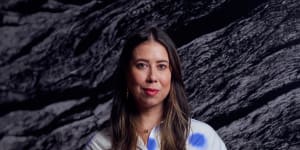As part of that process,London’s Tate Modern has appointed Yorta Yorta woman Kimberley Moulton as an adjunct curator,specialising in First Nations and Indigenous Art.

Kimberley Moulton will join the Tate Modern as a speacialist curator.Eugene Hyland
It’s a big appointment for the 38-year-old,who resigned as senior curator of the First Peoples collection at Melbourne Museum recently and will take up the part-time Tate role next month.
Also an associate artistic director of Melbourne’s Rising Festival,Moulton is the mind behind the festival’s stunningShadow Spirit exhibition,held at Flinders Street Station,which will tour later this year.
Moulton is employed to rethink the Tate’s collections and research through a non-western lens,and advise about acquisitions of Indigenous art. She joins a team of curators working within the Tate Research Centre:Transnational,one from Africa and another from the Caribbean,who will work from their home communities,visiting the gallery in person a few times a year. Integrated within Tate Modern’s curatorial team,the centre contributes to exhibitions,displays,acquisitions and events across Tate’s four galleries and with a wide network of collaborators.
“The Tate is one of the world’s leading art galleries and has a huge influence on how we consider art,how we interpret and understand the world through contemporary art. So it’s really important to have other voices in there,” Moulton says.

A still from the film The Umbra,by Hayley Millar Baker,shown at the Shadow Spirit exhibition.Supplied
“It’s about how we look at history really and what is considered to be art or what’s considered to be worthy of being in these institutions,and that’s often been led by or has its roots in white supremacy or the West being the Imperial power,” she says. “So it’s not about ignoring the art histories that we know but reframing and rethinking that through an Indigenous perspective as well and what that looks like.”
To her mind,the research centre is leading the space in critically looking at western art histories and rethinking and reframing what that can be. Indigenous artists have been making work about restitution and repatriation for a long time,a key focus for her. “The possibilities are expansive in the context of global Indigenous art and I’m excited to be going out into the world,as a Yorta Yorta woman from the country town of Shepparton,to hopefully impact our representation in art history.”
One of the world’s most significant galleries,the Tate has also appointed a curator dedicated to art and ecology for the first time: who is also an artist,based in London.
Director of program at the Tate Modern Catherine Wood said the appointments will “[advance] our ambition to present a truly international story of art through our program and collection”.
As Curator Emeritus at Melbourne Museum,Moulton maintains an ongoing relationship with the institution.“I’m looking forward to a change from curating within a museum collection that is predominantly based in 19th century cultural material and ancestral remains,this takes its toll as there is a lot of colonial trauma and violence that you have to work through on a daily basis,” she says. “I will continue to connect to collections through research and my love for them,and the responsibility I feel for them.”
She welcomes to their home,taken in the 1950s by a British anthropologist. Dolls made from shell and other significant pieces were returned to representatives of the Anindilyakwa community,from Groote Eylandt,about 50 kilometres from the north coast of mainland Australia.
Moulton says it’s a huge moment for the community but also,more broadly,for indigenous people worldwide. “To see the repatriation of cultural materials coming back from museums,particularly in the UK,I think that that says something.”
She met some of the Groote Eylandt artists recently who now are reunited with their ancestors’ creations,who spoke about making the shell dolls,a practice the returned collection will help revive and reclaim. ”I think it says that this repatriation can and should be based on relationships,not only handing back and returning cultural materials,but building relationships in the process that can be ongoing. This is a really beautiful example of that.”
The Booklist is a weekly newsletter for book lovers from books editor Jason Steger..
